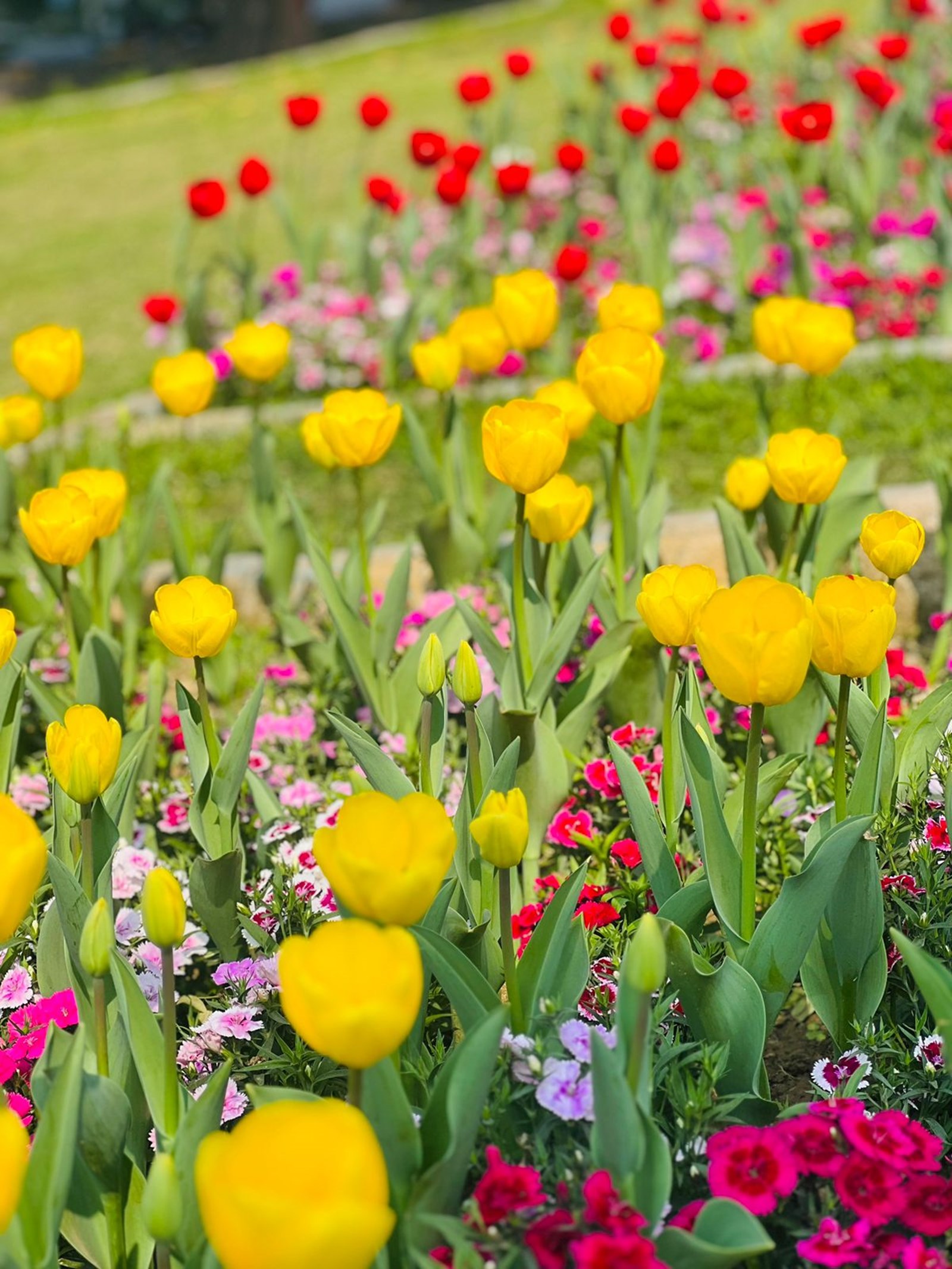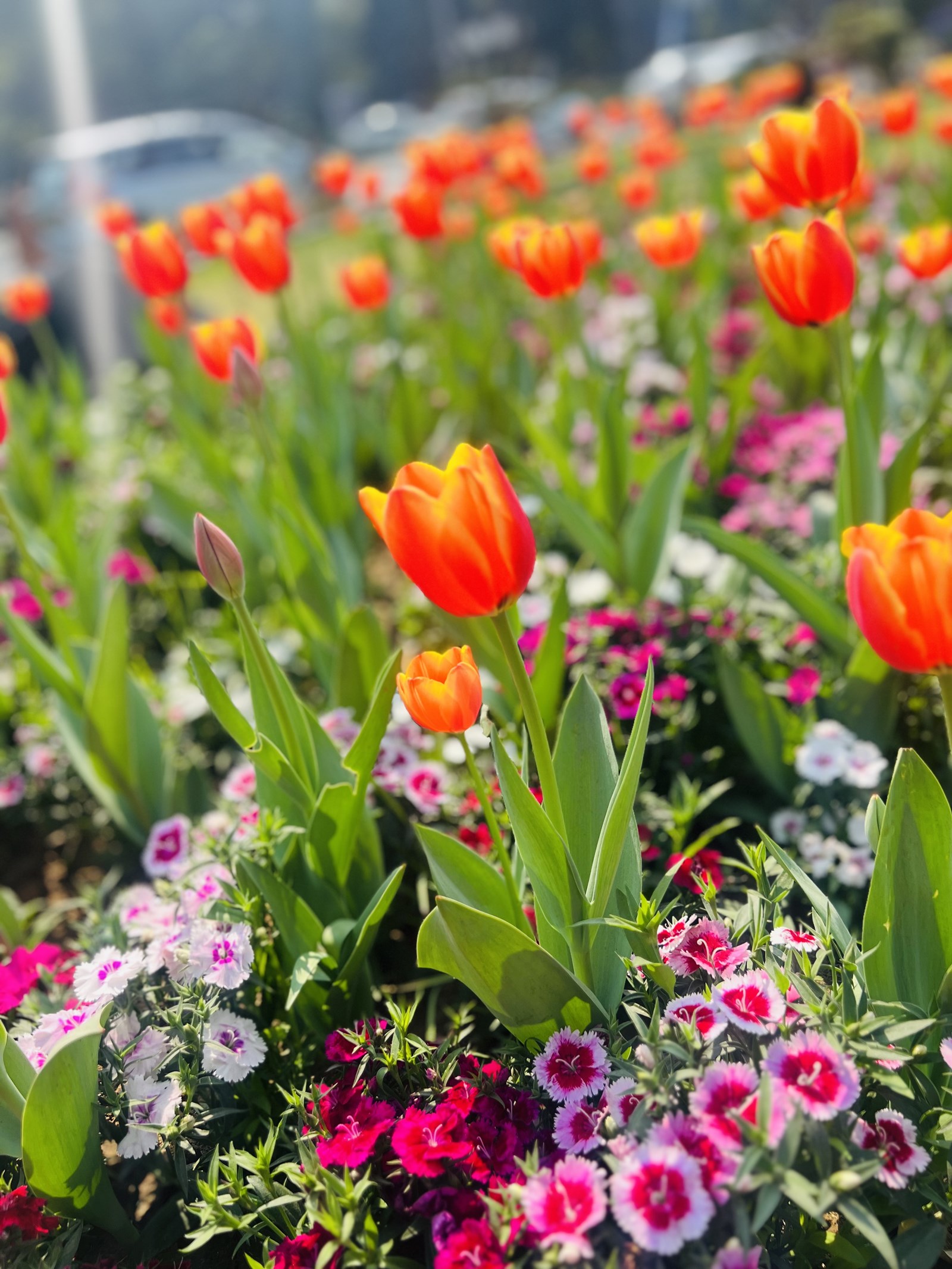Several roundabouts and parks in the New Delhi Municipal Council (NDMC) area greet you with these vibrant and happy tulips. As one walks past these beds of colours, mesmerising scenes from the movie Silsila (1981) come to mind. Two popular melodies, Dekha ek khwab and Yeh kahan aa gaye hum, were shot amid tulips in the famous Keukenhof gardens in the Netherlands back in the day.
For the last four years, the roundabouts in Delhi’s Chanakyapuri have lit up in these effervescent tulips in many colours as the NDMC has been organising the Delhi Tulip Festival across a 1.5 km stretch of Shanti Path. The festival’s second edition this year is being held from February 10 to 21.
‘A satiated bliss’
 Tulips have lit up the several roundabouts, parks, and public spaces providing people with natural recreation opportunities. (Credit: Swasti Pachauri)
Tulips have lit up the several roundabouts, parks, and public spaces providing people with natural recreation opportunities. (Credit: Swasti Pachauri)
A kind of public good, it is an initiative centred around promoting environmental consciousness, creating awareness about the history, natural heritage, green capital, and floriculture among the citizens while providing people with a means of recreation with nature.

“Flowers attract people towards them. Whoever comes here, goes away with a satiated bliss,” says Sachin Vashisht, 39, a gardener watering the roundabout at Teen Murti Marg.
Next to him are the orangish-red tulip flowers and another circle of sparkling orange and yellow tulips. The pink and purple tulips are a highlight here, with many photographers, couples, and people attempting to take selfies and trying to capture nature’s quiet calm amid racing vehicles. Then there are the pure yellow and red ones that glow even more as the sun makes them shimmer in the otherwise fading melancholy of the Delhi winter.
The light pink ones are still nascent and will bloom in a few days. Another variety, a deep orangish yellow, has become mature and is blooming abundantly, with larger and rounder leaves compared to others. The red and white tulips are a scintillating sight to behold, too.
Around seven varieties of tulips – red, orange, yellow, white, black, purple, and white – have been planted in phases in neatly manicured roundabouts, public parks, and gardens in and around Shanti Path. Around 200,000 bulbs of tulips brought from the Netherlands were planted at the end of December last year at various locations in and around Chanakya Puri with the help of dedicated and meticulous gardeners under the guidance of the horticulture department.
“Last year, we put black-red tulips right here; people loved them,” says Vashisht.
Natural recreation
 A total of seven different colours are see across the NDMC area. (Credit: Swasti Pachauri)
A total of seven different colours are see across the NDMC area. (Credit: Swasti Pachauri)
At the Shantipath lawns, recreation has a new meaning. Against the lovely educative banners mapping out “the history of tulips” to “Indo-dutch” diplomacy, families, children, and youngsters experiment with their cameras. Someone quietly reads a book, while many others snack on something they have got from home in the bright sunlight.
Vendors selling bhelpuri, chai, ram laddoo with chutney, ice creams, and cola – are ready to lure visitors, especially as the weather warms to encourage people to be out and about.
Asmita, a marketing professional from Gurgaon, is silently capturing the beauty of a redish-white tulip. “I had previously seen tulips on my official visit to Berlin once. After seeing several reels on Instagram, I came here because I love nature. These tulips bring a sense of calm and tranquillity to the eyes, with everyone, even kids, enjoying. Such steps are good for the ecosystem of cities,” she says.
At the Mandi House roundabout, professionals generally enjoy the calming essence of these flowers, with many others taking a quick nap. Students from the nearby National School of Drama do their rehearsals. The roundabouts imitate round tulip rangolis as people embrace the lovely hues of the spring season organised so elegantly by the authorities, keeping the objectives of environmental diplomacy and sustainability in mind.
Nature and nurture
 Most tulips have been planted with intercropping. (Credit: Swasti Pachauri)
Most tulips have been planted with intercropping. (Credit: Swasti Pachauri)
Raju, 43, a gardener working at Shantipath lawns since 2007, says, “These tulips are a result of the sustained efforts of NDMC and the adhikaaris (officials) working on this project. We have planted the tulip bulbs around 2-2.5 inches under the ground”.
Explaining the anatomy of the tulip bulb, he says, “The bulbs resemble those of the onion plant. We plant them in vertical flower beds in horizontal rows. The training for this has been provided to us by NDMC. They have also given us books with the entire map of the area based on which we plant these”.
Gardeners have grown these tulips following patterns of intercropping. At Shantipath, the tulips are neatly grown in rows intercropped with petunias and pansies. “These tulips will last only 15 days, after which the intercropped petunias, pansies, and other flowers will blossom,” says Raju.
This intercropping ensures that the parks and roundabouts are often adorned with flowers. Next to the rows of these tulips are also beds of Salvia Splendons, which are just beginning to bloom. At the Mandi House roundabout, yellow and red tulips have been precisely intercropped with white, pink, and maroon dianthus flowers.
The blooms here are a testament to the deep care and nurture these “hitherto” exotic varieties of flowers need. Keeping the life cycle of flowers in mind, the bulbs have been planted in phases with late-blooming and early-blooming tulips. If the sun is sparing, the tulips will last a month or so. Immense care is needed for them to thrive – regular watering and insect protection.
“These tulips need a lot of hard work and dedication. They are expensive flowers, and there have been incidents of theft once or twice. The security personnel guard these lovely flowers,” says Vashisht.
He adds, “We work so hard, the authorities should also consider rewarding us with some award or memento.”
Flower advocacy, environmental consciousness
 The bulbs have been brought from the Netherlands. (Credit: Swasti Pachauri)
The bulbs have been brought from the Netherlands. (Credit: Swasti Pachauri)
Many activities like tulip walks, educational and informative discussions around these flowers, photo competitions, and music festivals have been organised. After the Tulip Festival is over, a floral-food festival serving culinary delights and recipes made of flowers will be a significant attraction in addition to a rose festival. Students are seen clicking selfies with the flowers. The parks and walkways have also become a hangout for people to unwind and host small picnics. Some marathoners enjoy practicing here.
Activities like tulip walks and exposure visits provide students with immense knowledge about cultural diplomacy, sustainability, and environmental cooperation. To motivate enthusiasts, nature lovers, photographers, and students, the NDMC also posts a “picture of the day” chosen by judges on social media platforms and banners at Shantipath, encouraging community participation, green infrastructure, flower-based tourism.
Way forward
 A bouquet of these flowers greet people. (Credit: Swasti Pachauri)
A bouquet of these flowers greet people. (Credit: Swasti Pachauri)
One can draw inspiration from the famous Tulip Garden in Srinagar and have a similar initiative in Delhi (considering the constraints of temperatures) to create more flower-based, natural-heritage tourism opportunities.
These efforts are under the aegis of the larger objectives of making Delhi “a city of flowers” and promoting flower and nature-based tourism in the city known for its natural and green heritage with ancestral trees and monuments. Festivals such as these provide much-needed recreational opportunities amid nature and also contribute to the objectives of “smart cities”.
Meditation camps, yogic kheti, and yoga camps can be organised in addition to all these activities in different parts of Delhi. School and college students can be engaged with “green internships” where they can act as volunteers and custodians of these exotic flowers. Additionally, for enthusiasts, flower workshops using bouquet arrangements and awareness workshops for florists could also be undertaken with the help of experts.




 Tulips have lit up the several roundabouts, parks, and public spaces providing people with natural recreation opportunities. (Credit: Swasti Pachauri)
Tulips have lit up the several roundabouts, parks, and public spaces providing people with natural recreation opportunities. (Credit: Swasti Pachauri)
 A total of seven different colours are see across the NDMC area. (Credit: Swasti Pachauri)
A total of seven different colours are see across the NDMC area. (Credit: Swasti Pachauri) Most tulips have been planted with intercropping. (Credit: Swasti Pachauri)
Most tulips have been planted with intercropping. (Credit: Swasti Pachauri) The bulbs have been brought from the Netherlands. (Credit: Swasti Pachauri)
The bulbs have been brought from the Netherlands. (Credit: Swasti Pachauri) A bouquet of these flowers greet people. (Credit: Swasti Pachauri)
A bouquet of these flowers greet people. (Credit: Swasti Pachauri)


